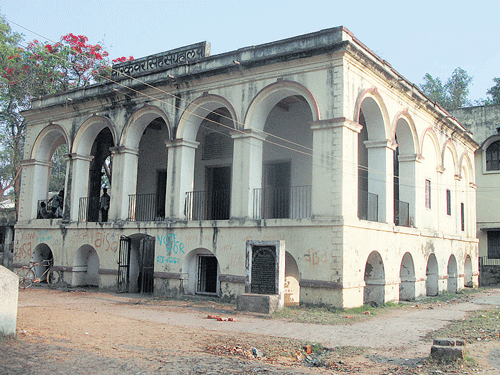
Thousands of tourists, including foreign and domestic, fly down to Patna to visit Buddhists historical sites at Nalanda, Rajgir, Vaishali and Bodh Gaya. But hardly anyone cares to visit or know about the legendary Veer Kunwar Singh, one of the most important freedom fighters in the Sepoy Mutiny of 1857.
Singh’s museum, also called Ara House (commonly known as Veer Kunwar Singh Sanghralaya), is in Bhojpur district where the great warrior Kunwar Singh, at the age of 80, made strategies to wage a decisive battle against the British.
The government’s apathy and indifferent attitude towards one of the real heros of the national movement could be gauged from the fact that the Ara House, though called a museum, hardly has any item related to Kunwar Singh.
Call it a sheer coincidence, Chief Justice of Patna High Court L Narasimha Reddy was recently returning to Patna from Bikramganj when he decided to visit Ara House on the Maharaja College campus in Bhojpur. The Chief Justice was briefed on the freedom struggle launched by Kunwar Singh and also about an old tunnel at Ara House which originated there but culminated at Jagdishpur, the birthplace of Kunwar Singh. This tunnel, used by freedom fighters during the national movement, had been blocked long back.
The judge evinced interest in the monument and asked the State’s Art and Culture Department to collect items related to Kunwar Singh and place them in Ara House so that the museum could attract tourists from all over the country. The Bihar government was directed to revamp the site with a fresh coat of paint and explore the possibility of reopening the tunnel. The local administration was asked to make sure that the people wanting to see the tunnel should not feel suffocated while passing through it.
Following the directive from the top jurist, Bihar’s Art and Culture Department is now preparing a blueprint where it will not only refurbish Ara House but also make it one of the prime tourist spots. “We will prepare a scheme for all-round development of Ara House and ensure that it becomes one of the prime tourist attractions in the state,” VK Singh, Principal Secretary of Art and Culture Department, told Deccan Herald. “Kunwar Singh, who played a significant role in freedom movement, is actually a source of inspiration for all of us. But not much is known about him as even 68 years after Independence, he was not given due recognition for the role he played during freedom struggle,” lamented educationist Rakesh Singh.
Born in Jagdishpur (in Bhojpur district), Kunwar Singh was 80 when the Great Rising of 1857 took place. At that time, people from all over India rose against the British rule. The octogenarian, despite his age and failing health, plunged into the first battle against the British and led the mutiny with undaunted courage.
On July 5, 1857, Kunwar Singh assumed command of a group of soldiers which had revolted at Danapur, between Ara and Patna. In the next 48 hours, Kunwar and his soldiers had occupied Arrah, (as Ara was known then). An expert in the art of guerrilla warfare, he was the first Indian warrior after Shivaji to prove the efficiency of the warfare.
The town remained occupied by the freedom fighter till Major Vincent Eyre defeated Kunwar Singh’s force and recaptured the town on August 3. In the battle, Major Eyre completely destroyed Jagdishpur, Kunwar’s ancestral place. As a consequence, the octogenarian moved towards Lucknow in December 1857. In the next three months, he, along with his handful soliders, captured Azamgarh (in UP).
But in March 1858, he had to leave the place as he was pursued by Brigadier Douglas and asked to leave for Bihar. On April 22, Kunwar Singh had a victory near Jagdishpur over the force led by Captain Le Grand, but the following day he died in his village.
It is believed that while crossing the Ganga on his way to Jagdishpur on April 22, he was wounded in the arm by the pursuing forces. The old warrior severed the injured limb and flung it into the Ganga as his last offering. Next day, he fought his last battle near Jagdishpur and completely routed the British forces. However, a wounded Kunwar Singh passed away on April 24, 1958.
Born in November 1777, Kunwar belonged to the Rajput clan. He wedded the daughter of a wealthy landlord of Gaya, Raja Fateh Narayan Singh, who was a descendant of Maharana Pratap of Mewar dynasty.
As a mark of respect for the contribution made by the legendary freedom fighter, the Union Government issued a memorial stamp in 1966. The Bihar Government headed by the then Chief Minister Lalu Prasad established Veer Kunwar Singh University in 1992.